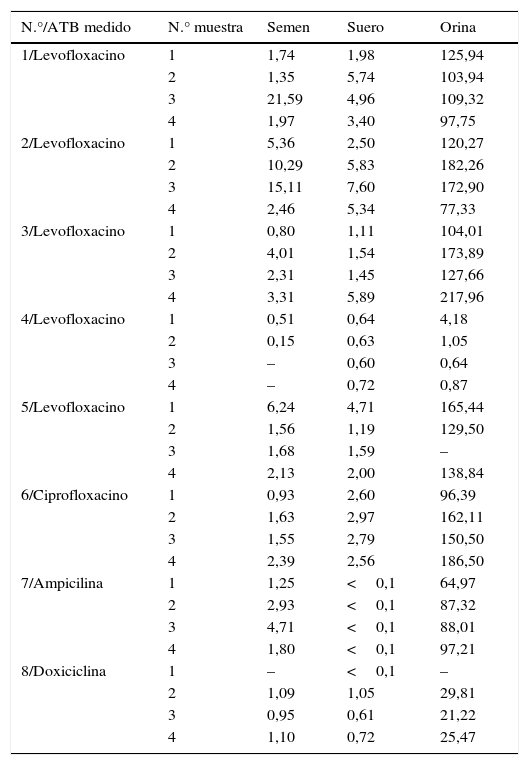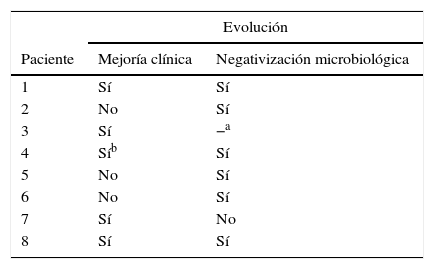La prostatitis crónica bacteriana (PCB) es la enfermedad urológica más frecuente en menores de 50 años, cuya clínica de larga evolución puede estar relacionada con una inadecuada pauta terapéutica. El objetivo fue analizar la sensibilidad de los microorganismos aislados de pacientes con PCB y medir las concentraciones de antibiótico semanalmente en suero, semen y orina.
Material y métodosPara el estudio de la sensibilidad antibiótica, entre enero de 2013 y diciembre de 2014 se incluyeron 60 aislados clínicos procedentes de muestras de semen de pacientes confirmados microbiológicamente con PCB, y se llevó a cabo por microdilución en caldo. Para el estudio de las concentraciones de antibióticos, entre los meses de enero y mayo de 2014 se recogieron muestras de orina, sangre y semen, semanalmente, durante 4 semanas de tratamiento de 8 pacientes con cultivo positivo para PCB, y se midieron las concentraciones mediante cromatografía de líquidos de ultra alta eficacia acoplada a espectrometría de masas en tándem (UHPLC-MS/MS).
ResultadosFosfomicina y nitrofurantoína fueron los antibióticos con mayor actividad (95,2% en ambos casos). Las concentraciones medias de antibiótico en semen durante las 4 semanas estudiadas fueron las siguientes: 1,68mg/l; 8,30mg/l; 2,61mg/l; 0,33mg/l y 2,90mg/l, respectivamente para los pacientes 1 a 5, que recibieron levofloxacino; 1,625mg/l para el paciente 6, que recibió ciprofloxacino 2,67mg/l para el paciente 7, que fue tratado con ampicilina, y 1,05mg/l para el paciente 8, que recibió doxiciclina. Se obtuvieron mayores concentraciones en las muestras de orina que en suero y semen, siendo comparables estas 2 últimas.
ConclusionesFosfomicina se postula como principal alternativa al tratamiento empírico de la PCB por su elevada actividad in vitro. La concentración de antibiótico en semen fue superior a la concentración mínima inhibitoria frente al agente etiológico, aunque no siempre se correlacionó la negativización microbiológica con la evolución clínica favorable.
Chronic bacterial prostatitis (CBP) is the most common urological disease in patients younger than 50 years, whose long-standing symptoms could be related to an inappropriate therapeutic regimen. The objective was to analyse the sensitivity of microorganisms isolated from patients with CBP and measure the weekly antibiotic concentrations in serum, semen and urine.
Material and methodsFor the antibiotic sensitivity study, 60 clinical isolates were included between January 2013 and December 2014 from semen samples from patients with microbiologically confirmed CBP. Broth microdilution was performed on the samples. For the antibiotic concentration study from January to May 2014, urine, blood and semen samples were collected weekly, over 4 weeks of treatment from 8 patients with positive cultures for CBP. The concentrations were measured using ultra-high performance liquid chromatography coupled to tandem mass spectrometry (UHPLC-MS/MS).
ResultsThe antibiotics fosfomycin and nitrofurantoin had the highest activity (95.2% in both cases). The mean antibiotic concentrations in semen during the 4 weeks studied were as follows: 1.68mg/L, 8.30mg/L, 2.61mg/L, 0.33mg/L and 2.90mg/L, respectively, for patients 1 to 5, who were treated with levofloxacin; 1.625mg/L for patient 6, who was treated with ciprofloxacin; 2.67mg/L for patient 7, who was treated with ampicillin; and 1.05mg/L for patient 8, who was treated with doxycycline. Higher concentrations were obtained in the urine samples than in serum and semen, the latter 2 of which were comparable.
ConclusionsFosfomycin is proposed as the primary alternative to the empiric treatment of CBP due to its high in vitro activity. The antibiotic concentration in semen was higher than the minimal inhibitory concentration against the aetiological agent, although microbiological negativisation was not always correlated with a favourable clinical outcome.
Artículo
Comprando el artículo el PDF del mismo podrá ser descargado
Precio 19,34 €
Comprar ahora














